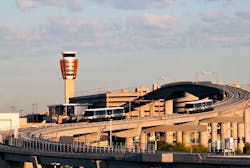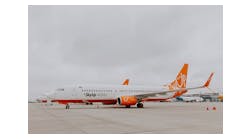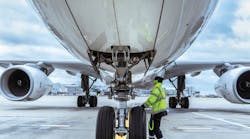Jim Bennett, A.A.E. was named director of aviation services for Phoenix in August 2015, where he oversees three airports: Phoenix Sky Harbor International, Phoenix Deer Valley and Phoenix Goodyear. The job is a homecoming of sorts, since he served as the city’s assistant aviation director at Sky Harbor from 1988 to 1996. In that job, he oversaw construction and development of Terminal 4 and supervised the airport's finance, engineering, planning and maintenance operations, among other duties.
In his career, Bennett served as president and CEO of the Metropolitan Washington Airports Authority (MWAA), which manages Ronald Reagan Washington National and Washington Dulles International airports. He also served as CEO for the UAE-based Abu Dhabi Airports Company, where he oversaw five airports in Abu Dhabi. He also served as president of his own consulting firm, serving foreign and domestic transportation companies.
Bennett has a Bachelor’s of Aviation Management from Auburn University and a Master of Public Administration from the University of Michigan. His professional affiliations include being the former chairman of the American Association of Airport Executives and a past president of the Arizona Airports Association. He spoke to Airport Business magazine about his first industry job, overseeing major capital projects at MWAA and in Abu Dhabi, his return to Sky Harbor and the projects he’s overseeing there.
Airport Business: What was your first airport job in the industry and how did you get it?
Jim Bennett: My first airport job was when I was a senior in high school. I got a summer job driving a tractor cutting grass at Birmingham Municipal Airport. From that point on, I knew I wanted to be in aviation business and work at an airport. I was bitten by the bug early on. While I was at Auburn, I had a co-op job at Birmingham [Shuttlesworth International] airport.
After graduation, I moved to Washington, D.C., and became manager of technical services for the Airport Operators Council International, which is now ACI-NA. I then went to Flint, Mich., where I was director of aeronautics.
AB: You oversaw the D2 capital improvement program at Washington Dulles International Airport. Why did MWAA think it was needed at the time?
JB: It was needed in order to transform Dulles and move it into the modern aviation industry. We needed to make facilities that were able to accommodate today’s aviation industry. When Dulles was originally built and opened in 1962, there were no gates. Aircraft were parked on hardstands and passengers were driven to be loaded on their planes using mobile lounges. The industry has evolved since then and we needed to put in the infrastructure to accommodate that.
AB: After 15 years at MWAA, you retired and took over as head of Abu Dhabi Airports Company. Why was that job so intriguing to you?
JB: I had always been intrigued about exploring how the model of a non-U.S. airport operated. Abu Dhabi Airports Company gave me the opportunity to be the CEO at another operating model. The airports company had a very aggressive capital development program underway and I wanted to experience putting that together.
AB: What were your biggest accomplishments during your tenure in Abu Dhabi?
JB: Probably one of my biggest accomplishments was getting all the contracts in place for the development of a new midfield terminal at Abu Dhabi International Airport that they’re still building. We had to get through the procurement process, get it under contract and get the work started.
AB: Now you’re back at Sky Harbor International Airport. What made this job so attractive to you?
JB: Anyone who has ever known me knows I enjoyed my previous time at Sky Harbor, where I worked for eight years as assistant aviation director. I developed an affection for Phoenix and Arizona, and I never thought I’d have another opportunity that would have allowed me to come back to Sky Harbor. I loved my time here previously, and now it’s like I never left.
AB: You’re overseeing myriad projects at Sky Harbor, including the renovation of Terminal 3, an upgrade of the international facilities, bringing on new retail outlets, building an eight-gate concourse in Terminal 4 and adding an extension to the Sky Train. Why are these projects needed?
JB: Sky Harbor is the 11th-busiest airport in the U.S. and in the top 25 in the world in terms of size. All of our infrastructure is being used to the maximum. We’re trying to position the airport so it can accommodate the future air transportation needs of Phoenix and Arizona.
When we finish this program, we will have space available on the west side of the airport so that as air travel demand continues to grow, the airport will be in a position to build terminals and continue to grow on our current site. Not all airports have the luxury of large parcels of real estate like Denver International, Dallas/Fort Worth and Dulles. Sky Harbor has 3,000 acres of real estate, so we have to be smart about how we use it. We need to be efficient and get ready for the future.
AB: How will the airport look and function once these projects are completed?
JB: Passengers will see a new ground transportation system in terms of landside access. Sky Harbor has one of the largest fleet of buses, at 108, to shuttle passengers between the airport and the consolidated rental car center. When the Sky Train is completed, they will be able to take the train, which will be easier and offer a higher level of customer service.
With the Terminal 3 modernization, the airlines in Terminal 2 will relocated to T3 and T2 will be torn down. Those customers will then have access to a state-of-the-art, common-use terminal for ticket counters and gates. As the airlines grow, they will have 25 gates available, which is exciting. The T3 opening will also give us the opportunity to expand our successful concessions program in T4, bringing more access to local restaurants and retail stores.
In T4, we’re building our eighth and final concourse, with eight more gates for Southwest Airlines. This will take them from 24 to 32 total gates at Sky Harbor. We think this is a strong signal of Southwest’s continued plans for its operation at Sky Harbor and this is exciting for Phoenix.





